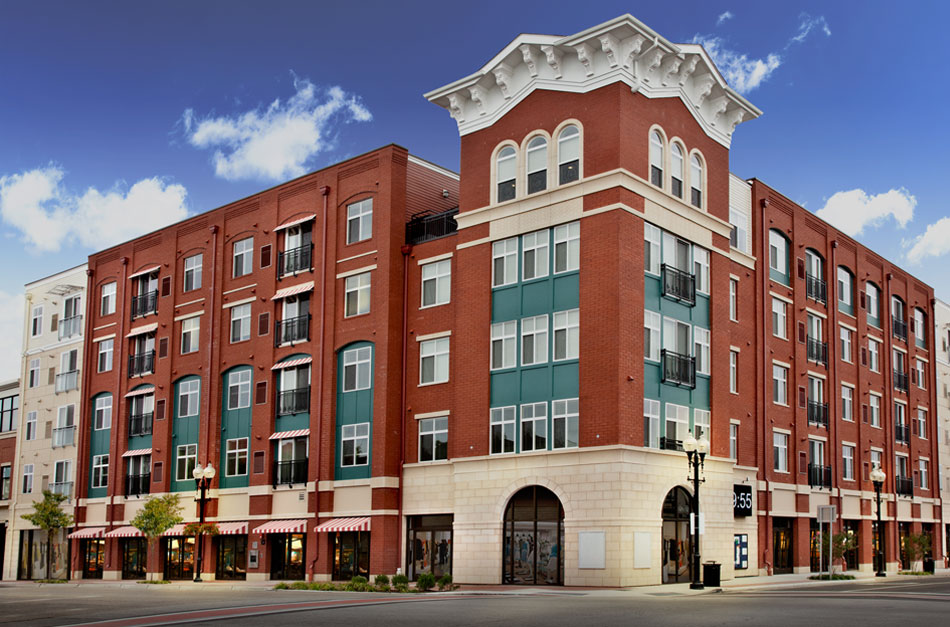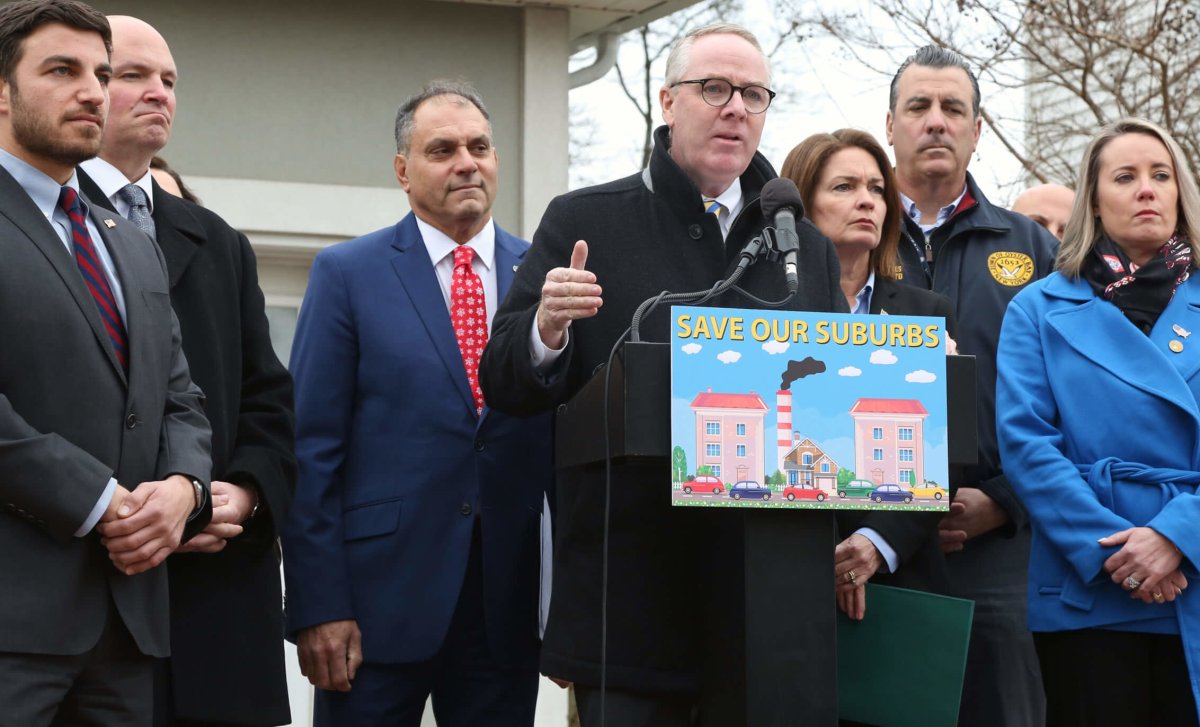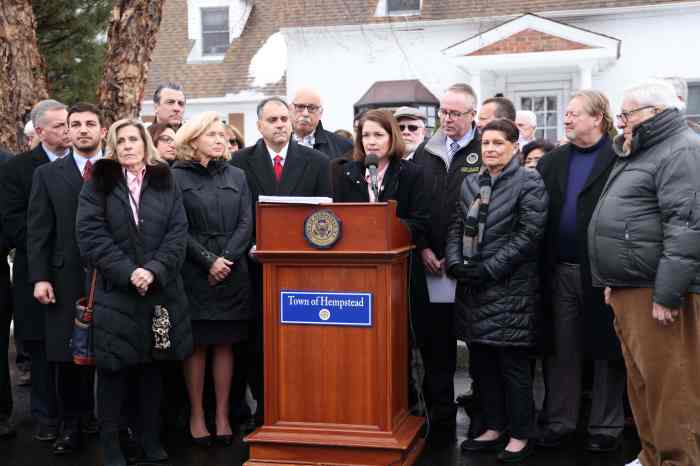Gov. Kathy Hochul revived her battle with Long Island officials who control residential zoning laws that the governor argues fuel the Brain Drain and localities say preserve the region’s way of life.
Some leaders of the 13 town governments that largely dictate the rules of real estate development in Nassau and Suffolk counties panned the governor’s New York Housing Compact proposal that aims to build 800,000 new homes statewide over the next decade to address the housing crisis — and would give New York State the power to fast track and overrule local decisions on proposed developments. The debate pits Democrats in Albany who control New York State government against local government leaders on LI, where Republicans have the majorities in most town governments.
“Over the last 10 years, our state has created 1.2 million jobs, but only 400,000 new homes,” Hochul said in her State of the State address, a third of which focused on her housing plan. “Many forces led to this state of affairs. But front and center are the local land use policies that are the most restrictive in the nation. Through zoning, local communities hold enormous power to block growth. Between full-on bans of multi-family homes, and onerous zoning and approvals processes, they make it difficult — even impossible — to build new homes.”
The proposal comes after voters in the East End towns of East Hampton, Southampton, Southold and Shelter Island approved referenda creating a 0.5% real estate tax to fuel affordable housing projects. Hochul’s plan revives a debate the governor sparked with her Accessory Dwelling Unit proposal that she withdrew last year following widespread opposition to the idea of creating more apartments in existing single-family homes.
“Residents take root on Long Island because it’s what they want: a single-family home suburban quality of life,” said Hempstead Town Supervisor Don Clavin. “We’re not going to let Albany force us into changing our residential neighborhoods into city-like landscapes.”

BIG CHANGES PLANNED
Between 2010 and 2018, Nassau, Suffolk, Westchester, and Putnam counties each granted fewer building permits per capita than virtually all suburban counties across Massachusetts, Connecticut, Southern California, New Jersey, Pennsylvania, and Northern Virginia, the governor said.
Nassau, which the latest U.S. Census data shows has more than 478,000 housing units, would be required to build an estimated 14,340 additional housing units over the course of three years, under the proposal. The compact calls for a 3% increase in housing stock every three years across the downstate region.
“In our small towns and villages, just a handful of new homes will mean they hit their targets,” Hochul said. “But the reality is that some communities will need to effect real change to build the homes we need.”
Critics say the fast track approval program would strip municipalities of their ability to combat the unwanted housing developments, worsen traffic, strain local infrastructure and overwhelm schools.
“The fact of the matter is that any radical expansion of housing in our suburban communities on Long Island is going to negatively impact our quality of life,” state Assemblyman Jarett Gandolfo (R-Sayville) said. “We simply do not have the infrastructure to handle such an increase in population density. We already have massive problems with traffic and wastewater management, not to mention the impact this will have on our school districts, as student-to-teacher ratios will inevitably increase.”
Hochul said localities would get help from the state in the form of new funding for infrastructure such as schools, roads, and sewers.

COMBATING BRAIN DRAIN
Local advocates add that the high number of people moving away from the region and the state due to the housing crisis shows the problem needs to be addressed. The phenomenon known as the Brain Drain siphons off the region’s educated professionals and other talented individuals.
“It is clear to every Long Islander that our lack of housing – especially affordable housing – is beyond a crisis,” said Ian Wilder, executive director of Long Island Housing Services, Inc. “The methods that we have historically used on Long Island to allocate the production of housing have been failing us all for quite some time. It is past due for us to make a complete overhaul of our antiquated laws to meet our current housing needs.”
Critics remain concerned with the mandate to rezone areas within a half mile of Long Island Rail Road stations to build transit-oriented housing and then expedite the environmental review process for such projects. Some Republicans agreed that housing is an issue, but remained skeptical of Hochul’s proposal.
“Local zoning control is vital to communities determining their future,” said state Assemblyman Jake Blumencranz (R-Oyster Bay). “This unprecedented proposal by the governor will now usurp that power and hand it to developers and special interest groups in Albany.”
Hunter Gross, president of the Huntington Township Housing Coalition, argued the need outweighs such concerns.
“The legalization of multi-family homes near railroad stations across the Town of Huntington will create substantial housing opportunities for various groups such as recent college graduates, seniors with fixed incomes, people of color, those in the disability community, working families, and so much more,” Gross said.
“This is not a one-size-fits-all approach,” Hochul said. “Local governments can meet these targets however they want and shape the ways they expand building capacity, such as redeveloping old malls and office parks, incentivizing new housing production, or updating zoning rules to reduce barriers.
“But when communities haven’t made good-faith efforts to grow when proposed housing projects are languishing for no legitimate reason, the state will implement a new fast-track approval process,” she continued. “Because to do nothing is an abdication of our responsibility to act in times of crisis.”




























